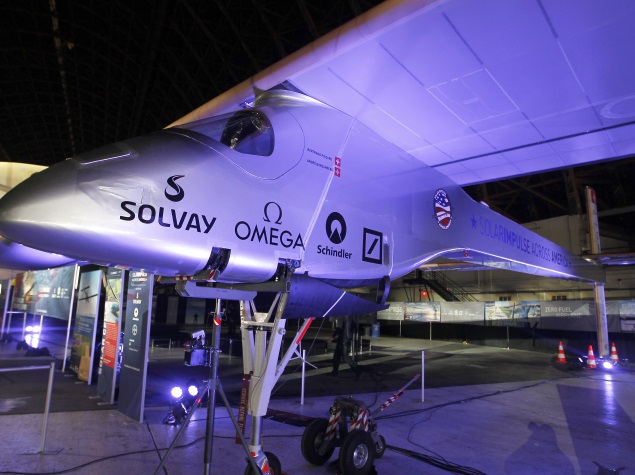- Home
- Science
- Science News
- Toughest Leg of Solar Impulse 2's Round the World Trip Delayed
Toughest Leg of Solar Impulse 2's Round-the-World Trip Delayed

The single-seater aircraft was due to leave Nanjing, in eastern China, for the 8,500 kilometre (5,270 mile) flight over the Pacific Ocean to the US island of Hawaii in the early hours of the morning.
But the much-anticipated seventh and longest section of the maiden solar-powered global circumnavigation was delayed once again due to concerns about the weather.
"The flight that we've been looking forward to tonight is not going to happen," Solar Impulse spokesman Connor Lennon said in a video post on the group's YouTube channel.
Mission director Raymond Clerc said cloud cover over Nanjing and the Sea of Japan made take-off difficult and the journey would have taken an unacceptably long seven days and seven nights, two more than originally planned.
"We have big problems that added (together) make the risk too high," he said in the video.
Meteorologists are studying weather conditions and should know in "a few hours" whether the aircraft will be able to launch in the next couple of days, he added.
Solar Impulse 2 has already spent nearly two months in China after arriving at Chongqing airport from Myanmar on March 31, where it was also held up for weeks by weather issues.
Its journey began in Abu Dhabi in March and is scheduled to take 12 legs, with a total flight time of around 25 days.
Get your daily dose of tech news, reviews, and insights, in under 80 characters on Gadgets 360 Turbo. Connect with fellow tech lovers on our Forum. Follow us on X, Facebook, WhatsApp, Threads and Google News for instant updates. Catch all the action on our YouTube channel.
Related Stories
- Samsung Galaxy Unpacked 2025
- ChatGPT
- Redmi Note 14 Pro+
- iPhone 16
- Apple Vision Pro
- Oneplus 12
- OnePlus Nord CE 3 Lite 5G
- iPhone 13
- Xiaomi 14 Pro
- Oppo Find N3
- Tecno Spark Go (2023)
- Realme V30
- Best Phones Under 25000
- Samsung Galaxy S24 Series
- Cryptocurrency
- iQoo 12
- Samsung Galaxy S24 Ultra
- Giottus
- Samsung Galaxy Z Flip 5
- Apple 'Scary Fast'
- Housefull 5
- GoPro Hero 12 Black Review
- Invincible Season 2
- JioGlass
- HD Ready TV
- Laptop Under 50000
- Smartwatch Under 10000
- Latest Mobile Phones
- Compare Phones
- Honor Win RT
- Honor Win
- Xiaomi 17 Ultra Leica Edition
- Xiaomi 17 Ultra
- Huawei Nova 15
- Huawei Nova 15 Pro
- Huawei Nova 15 Ultra
- OnePlus 15R
- Asus ProArt P16
- MacBook Pro 14-inch (M5, 2025)
- OPPO Pad Air 5
- Huawei MatePad 11.5 (2026)
- Xiaomi Watch 5
- Huawei Watch 10th Anniversary Edition
- Acerpure Nitro Z Series 100-inch QLED TV
- Samsung 43 Inch LED Ultra HD (4K) Smart TV (UA43UE81AFULXL)
- Asus ROG Ally
- Nintendo Switch Lite
- Haier 1.6 Ton 5 Star Inverter Split AC (HSU19G-MZAID5BN-INV)
- Haier 1.6 Ton 5 Star Inverter Split AC (HSU19G-MZAIM5BN-INV)

















